Managing Emotions: A Leadership Perspective on EI at Work
VerifiedAdded on 2022/12/20
|36
|10062
|1
Homework Assignment
AI Summary
This assignment delves into the critical role of emotional intelligence (EI) in effective leadership within the workplace. It begins by defining EI and its components, then explores the organizational benefits of fostering EI, such as improved communication and problem-solving skills. The assignment prompts reflection on leadership experiences, providing examples of how emotions have been managed effectively in professional settings. It examines the relationship between emotionally intelligent employees and the achievement of business objectives, referencing EI models like Goleman's, and discusses the impact of EI on work health, safety, and the overall work environment. Furthermore, the assignment explores strategies for communicating with culturally diverse individuals, emphasizing active listening and open communication. Finally, it addresses the importance of organizational policies and procedures, including communication protocols, diversity and inclusion policies, and professional conduct, in promoting effective workplace relationships.
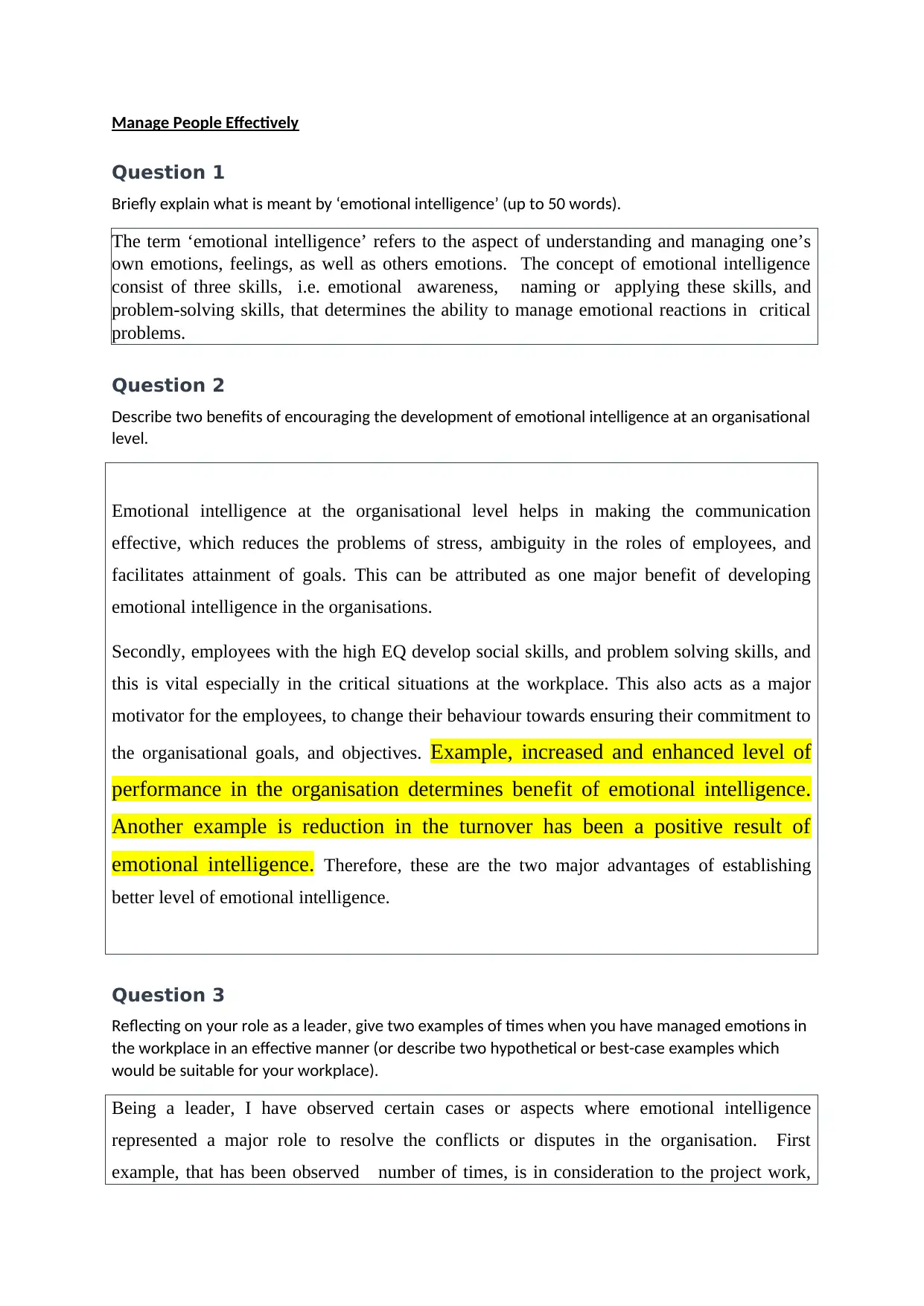
Manage People Effectively
Question 1
Briefly explain what is meant by ‘emotional intelligence’ (up to 50 words).
The term ‘emotional intelligence’ refers to the aspect of understanding and managing one’s
own emotions, feelings, as well as others emotions. The concept of emotional intelligence
consist of three skills, i.e. emotional awareness, naming or applying these skills, and
problem-solving skills, that determines the ability to manage emotional reactions in critical
problems.
Question 2
Describe two benefits of encouraging the development of emotional intelligence at an organisational
level.
Emotional intelligence at the organisational level helps in making the communication
effective, which reduces the problems of stress, ambiguity in the roles of employees, and
facilitates attainment of goals. This can be attributed as one major benefit of developing
emotional intelligence in the organisations.
Secondly, employees with the high EQ develop social skills, and problem solving skills, and
this is vital especially in the critical situations at the workplace. This also acts as a major
motivator for the employees, to change their behaviour towards ensuring their commitment to
the organisational goals, and objectives. Example, increased and enhanced level of
performance in the organisation determines benefit of emotional intelligence.
Another example is reduction in the turnover has been a positive result of
emotional intelligence. Therefore, these are the two major advantages of establishing
better level of emotional intelligence.
Question 3
Reflecting on your role as a leader, give two examples of times when you have managed emotions in
the workplace in an effective manner (or describe two hypothetical or best-case examples which
would be suitable for your workplace).
Being a leader, I have observed certain cases or aspects where emotional intelligence
represented a major role to resolve the conflicts or disputes in the organisation. First
example, that has been observed number of times, is in consideration to the project work,
Question 1
Briefly explain what is meant by ‘emotional intelligence’ (up to 50 words).
The term ‘emotional intelligence’ refers to the aspect of understanding and managing one’s
own emotions, feelings, as well as others emotions. The concept of emotional intelligence
consist of three skills, i.e. emotional awareness, naming or applying these skills, and
problem-solving skills, that determines the ability to manage emotional reactions in critical
problems.
Question 2
Describe two benefits of encouraging the development of emotional intelligence at an organisational
level.
Emotional intelligence at the organisational level helps in making the communication
effective, which reduces the problems of stress, ambiguity in the roles of employees, and
facilitates attainment of goals. This can be attributed as one major benefit of developing
emotional intelligence in the organisations.
Secondly, employees with the high EQ develop social skills, and problem solving skills, and
this is vital especially in the critical situations at the workplace. This also acts as a major
motivator for the employees, to change their behaviour towards ensuring their commitment to
the organisational goals, and objectives. Example, increased and enhanced level of
performance in the organisation determines benefit of emotional intelligence.
Another example is reduction in the turnover has been a positive result of
emotional intelligence. Therefore, these are the two major advantages of establishing
better level of emotional intelligence.
Question 3
Reflecting on your role as a leader, give two examples of times when you have managed emotions in
the workplace in an effective manner (or describe two hypothetical or best-case examples which
would be suitable for your workplace).
Being a leader, I have observed certain cases or aspects where emotional intelligence
represented a major role to resolve the conflicts or disputes in the organisation. First
example, that has been observed number of times, is in consideration to the project work,
Paraphrase This Document
Need a fresh take? Get an instant paraphrase of this document with our AI Paraphraser
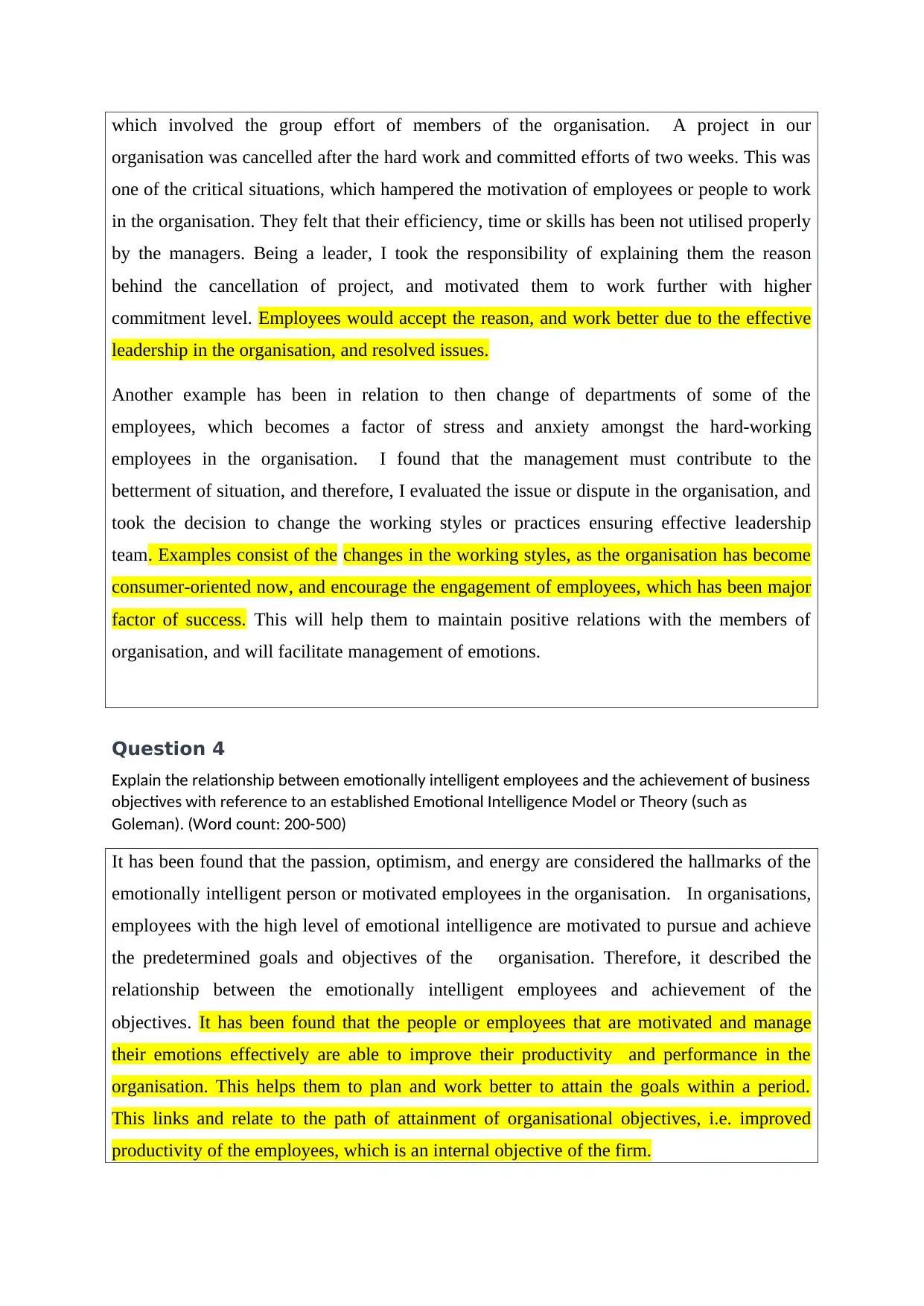
which involved the group effort of members of the organisation. A project in our
organisation was cancelled after the hard work and committed efforts of two weeks. This was
one of the critical situations, which hampered the motivation of employees or people to work
in the organisation. They felt that their efficiency, time or skills has been not utilised properly
by the managers. Being a leader, I took the responsibility of explaining them the reason
behind the cancellation of project, and motivated them to work further with higher
commitment level. Employees would accept the reason, and work better due to the effective
leadership in the organisation, and resolved issues.
Another example has been in relation to then change of departments of some of the
employees, which becomes a factor of stress and anxiety amongst the hard-working
employees in the organisation. I found that the management must contribute to the
betterment of situation, and therefore, I evaluated the issue or dispute in the organisation, and
took the decision to change the working styles or practices ensuring effective leadership
team. Examples consist of the changes in the working styles, as the organisation has become
consumer-oriented now, and encourage the engagement of employees, which has been major
factor of success. This will help them to maintain positive relations with the members of
organisation, and will facilitate management of emotions.
Question 4
Explain the relationship between emotionally intelligent employees and the achievement of business
objectives with reference to an established Emotional Intelligence Model or Theory (such as
Goleman). (Word count: 200-500)
It has been found that the passion, optimism, and energy are considered the hallmarks of the
emotionally intelligent person or motivated employees in the organisation. In organisations,
employees with the high level of emotional intelligence are motivated to pursue and achieve
the predetermined goals and objectives of the organisation. Therefore, it described the
relationship between the emotionally intelligent employees and achievement of the
objectives. It has been found that the people or employees that are motivated and manage
their emotions effectively are able to improve their productivity and performance in the
organisation. This helps them to plan and work better to attain the goals within a period.
This links and relate to the path of attainment of organisational objectives, i.e. improved
productivity of the employees, which is an internal objective of the firm.
organisation was cancelled after the hard work and committed efforts of two weeks. This was
one of the critical situations, which hampered the motivation of employees or people to work
in the organisation. They felt that their efficiency, time or skills has been not utilised properly
by the managers. Being a leader, I took the responsibility of explaining them the reason
behind the cancellation of project, and motivated them to work further with higher
commitment level. Employees would accept the reason, and work better due to the effective
leadership in the organisation, and resolved issues.
Another example has been in relation to then change of departments of some of the
employees, which becomes a factor of stress and anxiety amongst the hard-working
employees in the organisation. I found that the management must contribute to the
betterment of situation, and therefore, I evaluated the issue or dispute in the organisation, and
took the decision to change the working styles or practices ensuring effective leadership
team. Examples consist of the changes in the working styles, as the organisation has become
consumer-oriented now, and encourage the engagement of employees, which has been major
factor of success. This will help them to maintain positive relations with the members of
organisation, and will facilitate management of emotions.
Question 4
Explain the relationship between emotionally intelligent employees and the achievement of business
objectives with reference to an established Emotional Intelligence Model or Theory (such as
Goleman). (Word count: 200-500)
It has been found that the passion, optimism, and energy are considered the hallmarks of the
emotionally intelligent person or motivated employees in the organisation. In organisations,
employees with the high level of emotional intelligence are motivated to pursue and achieve
the predetermined goals and objectives of the organisation. Therefore, it described the
relationship between the emotionally intelligent employees and achievement of the
objectives. It has been found that the people or employees that are motivated and manage
their emotions effectively are able to improve their productivity and performance in the
organisation. This helps them to plan and work better to attain the goals within a period.
This links and relate to the path of attainment of organisational objectives, i.e. improved
productivity of the employees, which is an internal objective of the firm.
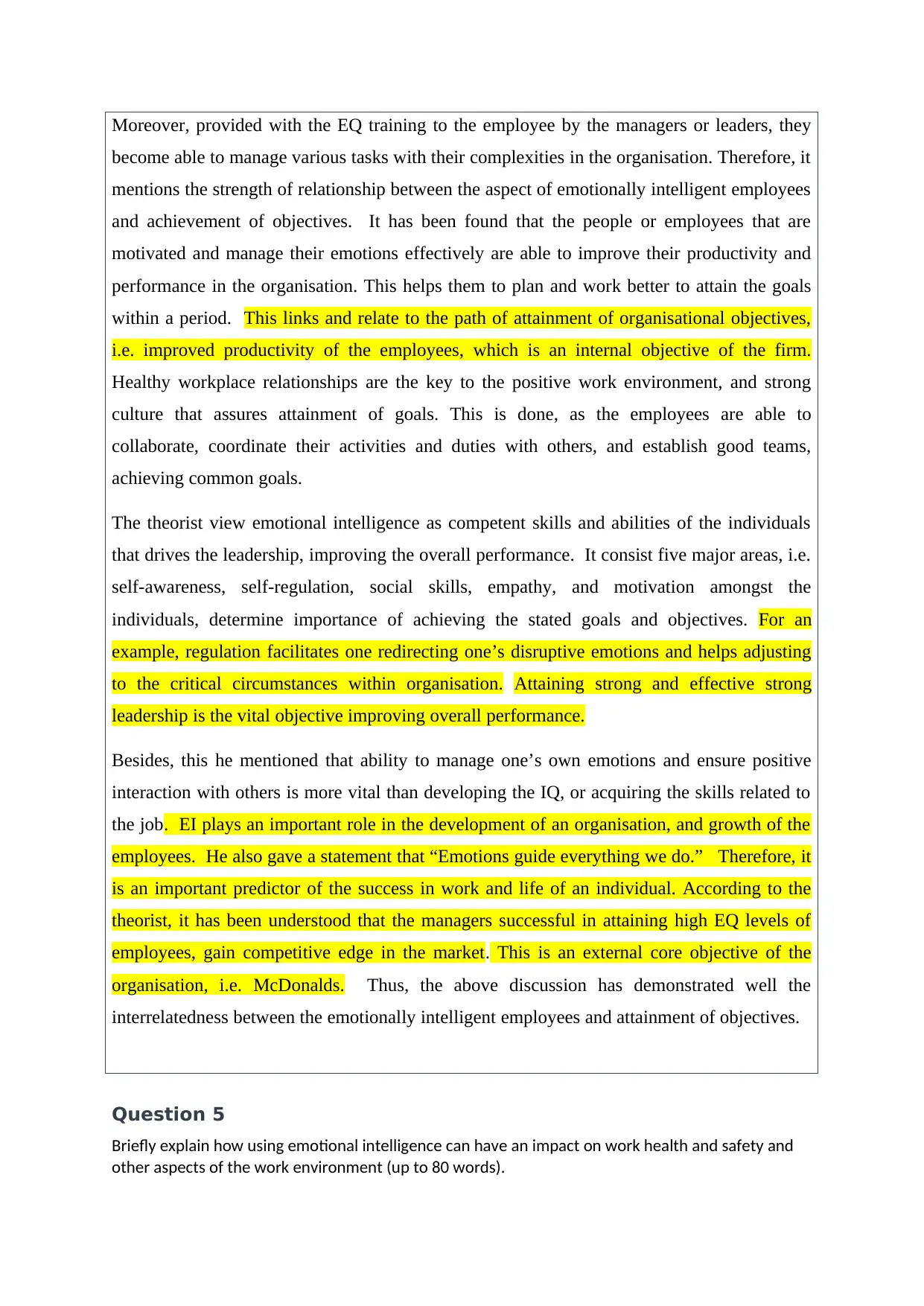
Moreover, provided with the EQ training to the employee by the managers or leaders, they
become able to manage various tasks with their complexities in the organisation. Therefore, it
mentions the strength of relationship between the aspect of emotionally intelligent employees
and achievement of objectives. It has been found that the people or employees that are
motivated and manage their emotions effectively are able to improve their productivity and
performance in the organisation. This helps them to plan and work better to attain the goals
within a period. This links and relate to the path of attainment of organisational objectives,
i.e. improved productivity of the employees, which is an internal objective of the firm.
Healthy workplace relationships are the key to the positive work environment, and strong
culture that assures attainment of goals. This is done, as the employees are able to
collaborate, coordinate their activities and duties with others, and establish good teams,
achieving common goals.
The theorist view emotional intelligence as competent skills and abilities of the individuals
that drives the leadership, improving the overall performance. It consist five major areas, i.e.
self-awareness, self-regulation, social skills, empathy, and motivation amongst the
individuals, determine importance of achieving the stated goals and objectives. For an
example, regulation facilitates one redirecting one’s disruptive emotions and helps adjusting
to the critical circumstances within organisation. Attaining strong and effective strong
leadership is the vital objective improving overall performance.
Besides, this he mentioned that ability to manage one’s own emotions and ensure positive
interaction with others is more vital than developing the IQ, or acquiring the skills related to
the job. EI plays an important role in the development of an organisation, and growth of the
employees. He also gave a statement that “Emotions guide everything we do.” Therefore, it
is an important predictor of the success in work and life of an individual. According to the
theorist, it has been understood that the managers successful in attaining high EQ levels of
employees, gain competitive edge in the market. This is an external core objective of the
organisation, i.e. McDonalds. Thus, the above discussion has demonstrated well the
interrelatedness between the emotionally intelligent employees and attainment of objectives.
Question 5
Briefly explain how using emotional intelligence can have an impact on work health and safety and
other aspects of the work environment (up to 80 words).
become able to manage various tasks with their complexities in the organisation. Therefore, it
mentions the strength of relationship between the aspect of emotionally intelligent employees
and achievement of objectives. It has been found that the people or employees that are
motivated and manage their emotions effectively are able to improve their productivity and
performance in the organisation. This helps them to plan and work better to attain the goals
within a period. This links and relate to the path of attainment of organisational objectives,
i.e. improved productivity of the employees, which is an internal objective of the firm.
Healthy workplace relationships are the key to the positive work environment, and strong
culture that assures attainment of goals. This is done, as the employees are able to
collaborate, coordinate their activities and duties with others, and establish good teams,
achieving common goals.
The theorist view emotional intelligence as competent skills and abilities of the individuals
that drives the leadership, improving the overall performance. It consist five major areas, i.e.
self-awareness, self-regulation, social skills, empathy, and motivation amongst the
individuals, determine importance of achieving the stated goals and objectives. For an
example, regulation facilitates one redirecting one’s disruptive emotions and helps adjusting
to the critical circumstances within organisation. Attaining strong and effective strong
leadership is the vital objective improving overall performance.
Besides, this he mentioned that ability to manage one’s own emotions and ensure positive
interaction with others is more vital than developing the IQ, or acquiring the skills related to
the job. EI plays an important role in the development of an organisation, and growth of the
employees. He also gave a statement that “Emotions guide everything we do.” Therefore, it
is an important predictor of the success in work and life of an individual. According to the
theorist, it has been understood that the managers successful in attaining high EQ levels of
employees, gain competitive edge in the market. This is an external core objective of the
organisation, i.e. McDonalds. Thus, the above discussion has demonstrated well the
interrelatedness between the emotionally intelligent employees and attainment of objectives.
Question 5
Briefly explain how using emotional intelligence can have an impact on work health and safety and
other aspects of the work environment (up to 80 words).
⊘ This is a preview!⊘
Do you want full access?
Subscribe today to unlock all pages.

Trusted by 1+ million students worldwide
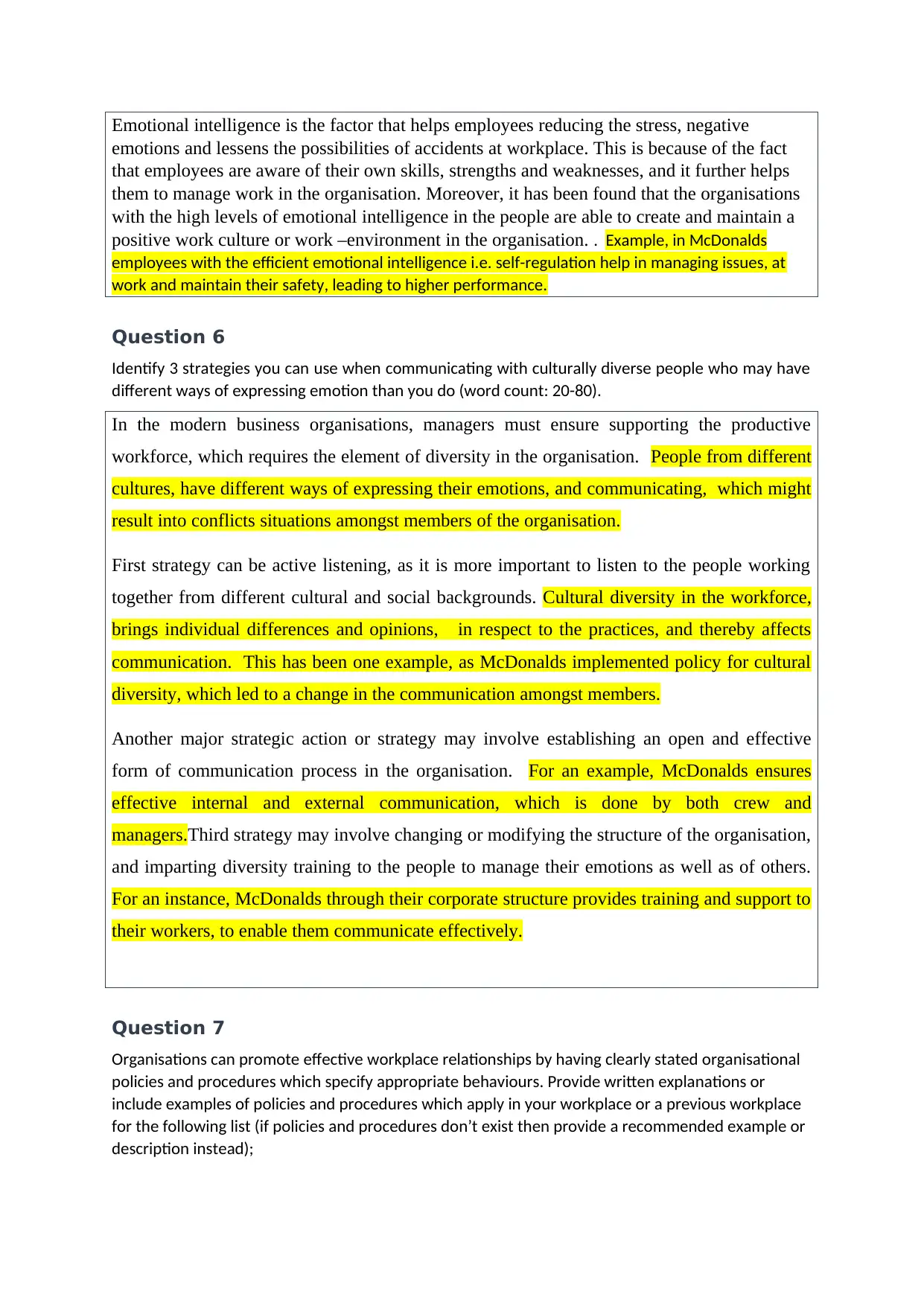
Emotional intelligence is the factor that helps employees reducing the stress, negative
emotions and lessens the possibilities of accidents at workplace. This is because of the fact
that employees are aware of their own skills, strengths and weaknesses, and it further helps
them to manage work in the organisation. Moreover, it has been found that the organisations
with the high levels of emotional intelligence in the people are able to create and maintain a
positive work culture or work –environment in the organisation. . Example, in McDonalds
employees with the efficient emotional intelligence i.e. self-regulation help in managing issues, at
work and maintain their safety, leading to higher performance.
Question 6
Identify 3 strategies you can use when communicating with culturally diverse people who may have
different ways of expressing emotion than you do (word count: 20-80).
In the modern business organisations, managers must ensure supporting the productive
workforce, which requires the element of diversity in the organisation. People from different
cultures, have different ways of expressing their emotions, and communicating, which might
result into conflicts situations amongst members of the organisation.
First strategy can be active listening, as it is more important to listen to the people working
together from different cultural and social backgrounds. Cultural diversity in the workforce,
brings individual differences and opinions, in respect to the practices, and thereby affects
communication. This has been one example, as McDonalds implemented policy for cultural
diversity, which led to a change in the communication amongst members.
Another major strategic action or strategy may involve establishing an open and effective
form of communication process in the organisation. For an example, McDonalds ensures
effective internal and external communication, which is done by both crew and
managers.Third strategy may involve changing or modifying the structure of the organisation,
and imparting diversity training to the people to manage their emotions as well as of others.
For an instance, McDonalds through their corporate structure provides training and support to
their workers, to enable them communicate effectively.
Question 7
Organisations can promote effective workplace relationships by having clearly stated organisational
policies and procedures which specify appropriate behaviours. Provide written explanations or
include examples of policies and procedures which apply in your workplace or a previous workplace
for the following list (if policies and procedures don’t exist then provide a recommended example or
description instead);
emotions and lessens the possibilities of accidents at workplace. This is because of the fact
that employees are aware of their own skills, strengths and weaknesses, and it further helps
them to manage work in the organisation. Moreover, it has been found that the organisations
with the high levels of emotional intelligence in the people are able to create and maintain a
positive work culture or work –environment in the organisation. . Example, in McDonalds
employees with the efficient emotional intelligence i.e. self-regulation help in managing issues, at
work and maintain their safety, leading to higher performance.
Question 6
Identify 3 strategies you can use when communicating with culturally diverse people who may have
different ways of expressing emotion than you do (word count: 20-80).
In the modern business organisations, managers must ensure supporting the productive
workforce, which requires the element of diversity in the organisation. People from different
cultures, have different ways of expressing their emotions, and communicating, which might
result into conflicts situations amongst members of the organisation.
First strategy can be active listening, as it is more important to listen to the people working
together from different cultural and social backgrounds. Cultural diversity in the workforce,
brings individual differences and opinions, in respect to the practices, and thereby affects
communication. This has been one example, as McDonalds implemented policy for cultural
diversity, which led to a change in the communication amongst members.
Another major strategic action or strategy may involve establishing an open and effective
form of communication process in the organisation. For an example, McDonalds ensures
effective internal and external communication, which is done by both crew and
managers.Third strategy may involve changing or modifying the structure of the organisation,
and imparting diversity training to the people to manage their emotions as well as of others.
For an instance, McDonalds through their corporate structure provides training and support to
their workers, to enable them communicate effectively.
Question 7
Organisations can promote effective workplace relationships by having clearly stated organisational
policies and procedures which specify appropriate behaviours. Provide written explanations or
include examples of policies and procedures which apply in your workplace or a previous workplace
for the following list (if policies and procedures don’t exist then provide a recommended example or
description instead);
Paraphrase This Document
Need a fresh take? Get an instant paraphrase of this document with our AI Paraphraser
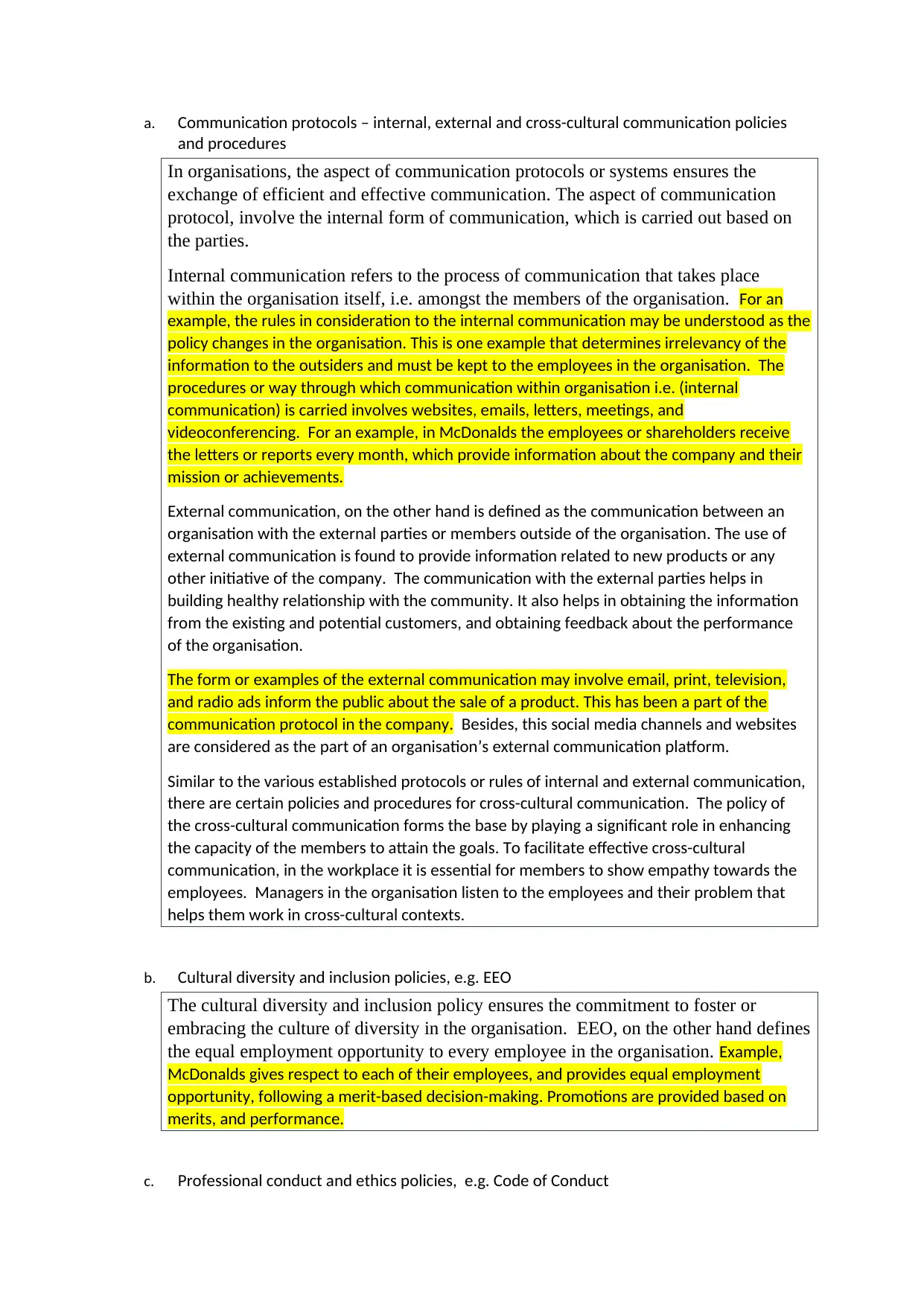
a. Communication protocols – internal, external and cross-cultural communication policies
and procedures
In organisations, the aspect of communication protocols or systems ensures the
exchange of efficient and effective communication. The aspect of communication
protocol, involve the internal form of communication, which is carried out based on
the parties.
Internal communication refers to the process of communication that takes place
within the organisation itself, i.e. amongst the members of the organisation. For an
example, the rules in consideration to the internal communication may be understood as the
policy changes in the organisation. This is one example that determines irrelevancy of the
information to the outsiders and must be kept to the employees in the organisation. The
procedures or way through which communication within organisation i.e. (internal
communication) is carried involves websites, emails, letters, meetings, and
videoconferencing. For an example, in McDonalds the employees or shareholders receive
the letters or reports every month, which provide information about the company and their
mission or achievements.
External communication, on the other hand is defined as the communication between an
organisation with the external parties or members outside of the organisation. The use of
external communication is found to provide information related to new products or any
other initiative of the company. The communication with the external parties helps in
building healthy relationship with the community. It also helps in obtaining the information
from the existing and potential customers, and obtaining feedback about the performance
of the organisation.
The form or examples of the external communication may involve email, print, television,
and radio ads inform the public about the sale of a product. This has been a part of the
communication protocol in the company. Besides, this social media channels and websites
are considered as the part of an organisation’s external communication platform.
Similar to the various established protocols or rules of internal and external communication,
there are certain policies and procedures for cross-cultural communication. The policy of
the cross-cultural communication forms the base by playing a significant role in enhancing
the capacity of the members to attain the goals. To facilitate effective cross-cultural
communication, in the workplace it is essential for members to show empathy towards the
employees. Managers in the organisation listen to the employees and their problem that
helps them work in cross-cultural contexts.
b. Cultural diversity and inclusion policies, e.g. EEO
The cultural diversity and inclusion policy ensures the commitment to foster or
embracing the culture of diversity in the organisation. EEO, on the other hand defines
the equal employment opportunity to every employee in the organisation. Example,
McDonalds gives respect to each of their employees, and provides equal employment
opportunity, following a merit-based decision-making. Promotions are provided based on
merits, and performance.
c. Professional conduct and ethics policies, e.g. Code of Conduct
and procedures
In organisations, the aspect of communication protocols or systems ensures the
exchange of efficient and effective communication. The aspect of communication
protocol, involve the internal form of communication, which is carried out based on
the parties.
Internal communication refers to the process of communication that takes place
within the organisation itself, i.e. amongst the members of the organisation. For an
example, the rules in consideration to the internal communication may be understood as the
policy changes in the organisation. This is one example that determines irrelevancy of the
information to the outsiders and must be kept to the employees in the organisation. The
procedures or way through which communication within organisation i.e. (internal
communication) is carried involves websites, emails, letters, meetings, and
videoconferencing. For an example, in McDonalds the employees or shareholders receive
the letters or reports every month, which provide information about the company and their
mission or achievements.
External communication, on the other hand is defined as the communication between an
organisation with the external parties or members outside of the organisation. The use of
external communication is found to provide information related to new products or any
other initiative of the company. The communication with the external parties helps in
building healthy relationship with the community. It also helps in obtaining the information
from the existing and potential customers, and obtaining feedback about the performance
of the organisation.
The form or examples of the external communication may involve email, print, television,
and radio ads inform the public about the sale of a product. This has been a part of the
communication protocol in the company. Besides, this social media channels and websites
are considered as the part of an organisation’s external communication platform.
Similar to the various established protocols or rules of internal and external communication,
there are certain policies and procedures for cross-cultural communication. The policy of
the cross-cultural communication forms the base by playing a significant role in enhancing
the capacity of the members to attain the goals. To facilitate effective cross-cultural
communication, in the workplace it is essential for members to show empathy towards the
employees. Managers in the organisation listen to the employees and their problem that
helps them work in cross-cultural contexts.
b. Cultural diversity and inclusion policies, e.g. EEO
The cultural diversity and inclusion policy ensures the commitment to foster or
embracing the culture of diversity in the organisation. EEO, on the other hand defines
the equal employment opportunity to every employee in the organisation. Example,
McDonalds gives respect to each of their employees, and provides equal employment
opportunity, following a merit-based decision-making. Promotions are provided based on
merits, and performance.
c. Professional conduct and ethics policies, e.g. Code of Conduct
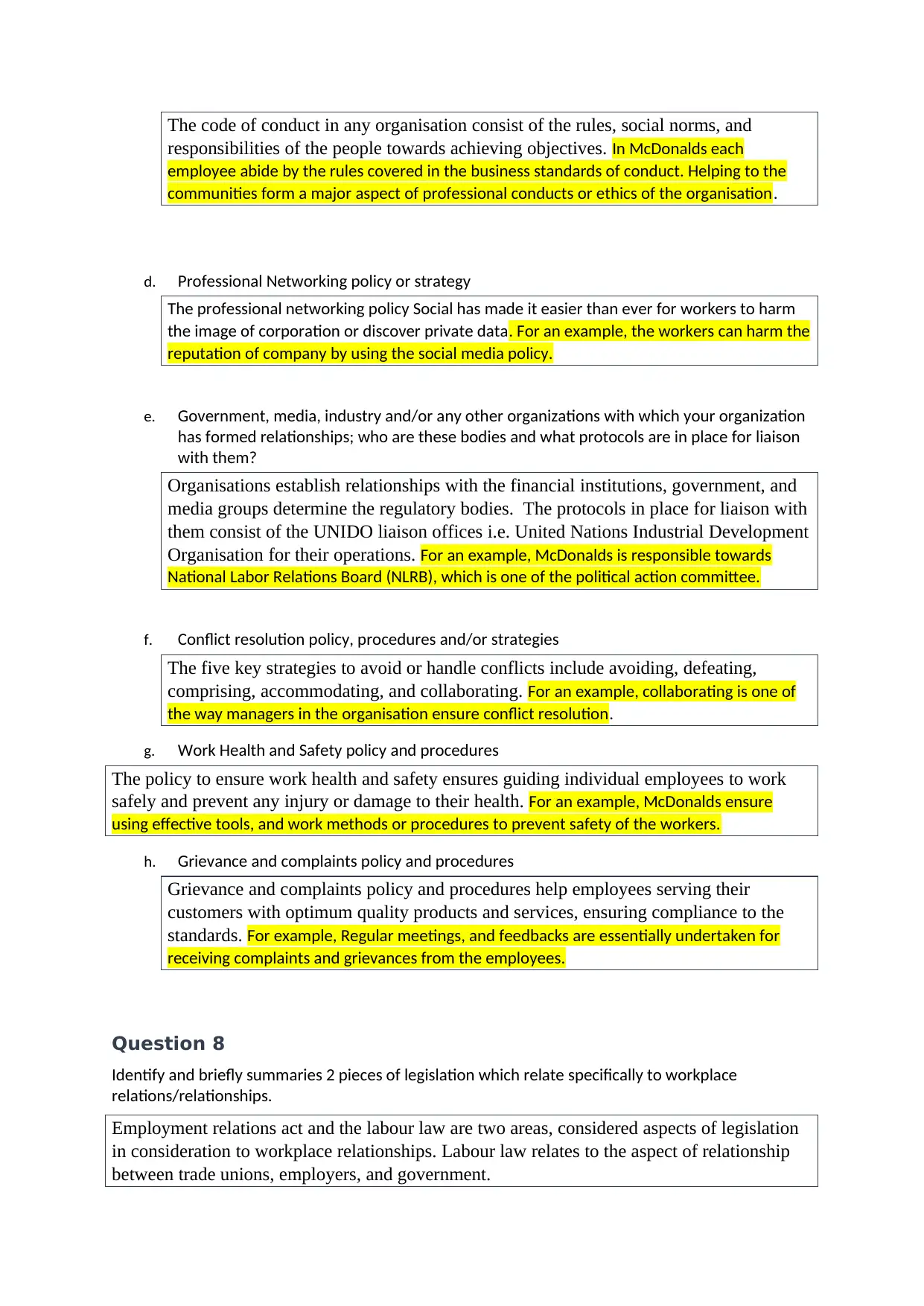
The code of conduct in any organisation consist of the rules, social norms, and
responsibilities of the people towards achieving objectives. In McDonalds each
employee abide by the rules covered in the business standards of conduct. Helping to the
communities form a major aspect of professional conducts or ethics of the organisation.
d. Professional Networking policy or strategy
The professional networking policy Social has made it easier than ever for workers to harm
the image of corporation or discover private data. For an example, the workers can harm the
reputation of company by using the social media policy.
e. Government, media, industry and/or any other organizations with which your organization
has formed relationships; who are these bodies and what protocols are in place for liaison
with them?
Organisations establish relationships with the financial institutions, government, and
media groups determine the regulatory bodies. The protocols in place for liaison with
them consist of the UNIDO liaison offices i.e. United Nations Industrial Development
Organisation for their operations. For an example, McDonalds is responsible towards
National Labor Relations Board (NLRB), which is one of the political action committee.
f. Conflict resolution policy, procedures and/or strategies
The five key strategies to avoid or handle conflicts include avoiding, defeating,
comprising, accommodating, and collaborating. For an example, collaborating is one of
the way managers in the organisation ensure conflict resolution.
g. Work Health and Safety policy and procedures
The policy to ensure work health and safety ensures guiding individual employees to work
safely and prevent any injury or damage to their health. For an example, McDonalds ensure
using effective tools, and work methods or procedures to prevent safety of the workers.
h. Grievance and complaints policy and procedures
Grievance and complaints policy and procedures help employees serving their
customers with optimum quality products and services, ensuring compliance to the
standards. For example, Regular meetings, and feedbacks are essentially undertaken for
receiving complaints and grievances from the employees.
Question 8
Identify and briefly summaries 2 pieces of legislation which relate specifically to workplace
relations/relationships.
Employment relations act and the labour law are two areas, considered aspects of legislation
in consideration to workplace relationships. Labour law relates to the aspect of relationship
between trade unions, employers, and government.
responsibilities of the people towards achieving objectives. In McDonalds each
employee abide by the rules covered in the business standards of conduct. Helping to the
communities form a major aspect of professional conducts or ethics of the organisation.
d. Professional Networking policy or strategy
The professional networking policy Social has made it easier than ever for workers to harm
the image of corporation or discover private data. For an example, the workers can harm the
reputation of company by using the social media policy.
e. Government, media, industry and/or any other organizations with which your organization
has formed relationships; who are these bodies and what protocols are in place for liaison
with them?
Organisations establish relationships with the financial institutions, government, and
media groups determine the regulatory bodies. The protocols in place for liaison with
them consist of the UNIDO liaison offices i.e. United Nations Industrial Development
Organisation for their operations. For an example, McDonalds is responsible towards
National Labor Relations Board (NLRB), which is one of the political action committee.
f. Conflict resolution policy, procedures and/or strategies
The five key strategies to avoid or handle conflicts include avoiding, defeating,
comprising, accommodating, and collaborating. For an example, collaborating is one of
the way managers in the organisation ensure conflict resolution.
g. Work Health and Safety policy and procedures
The policy to ensure work health and safety ensures guiding individual employees to work
safely and prevent any injury or damage to their health. For an example, McDonalds ensure
using effective tools, and work methods or procedures to prevent safety of the workers.
h. Grievance and complaints policy and procedures
Grievance and complaints policy and procedures help employees serving their
customers with optimum quality products and services, ensuring compliance to the
standards. For example, Regular meetings, and feedbacks are essentially undertaken for
receiving complaints and grievances from the employees.
Question 8
Identify and briefly summaries 2 pieces of legislation which relate specifically to workplace
relations/relationships.
Employment relations act and the labour law are two areas, considered aspects of legislation
in consideration to workplace relationships. Labour law relates to the aspect of relationship
between trade unions, employers, and government.
⊘ This is a preview!⊘
Do you want full access?
Subscribe today to unlock all pages.

Trusted by 1+ million students worldwide
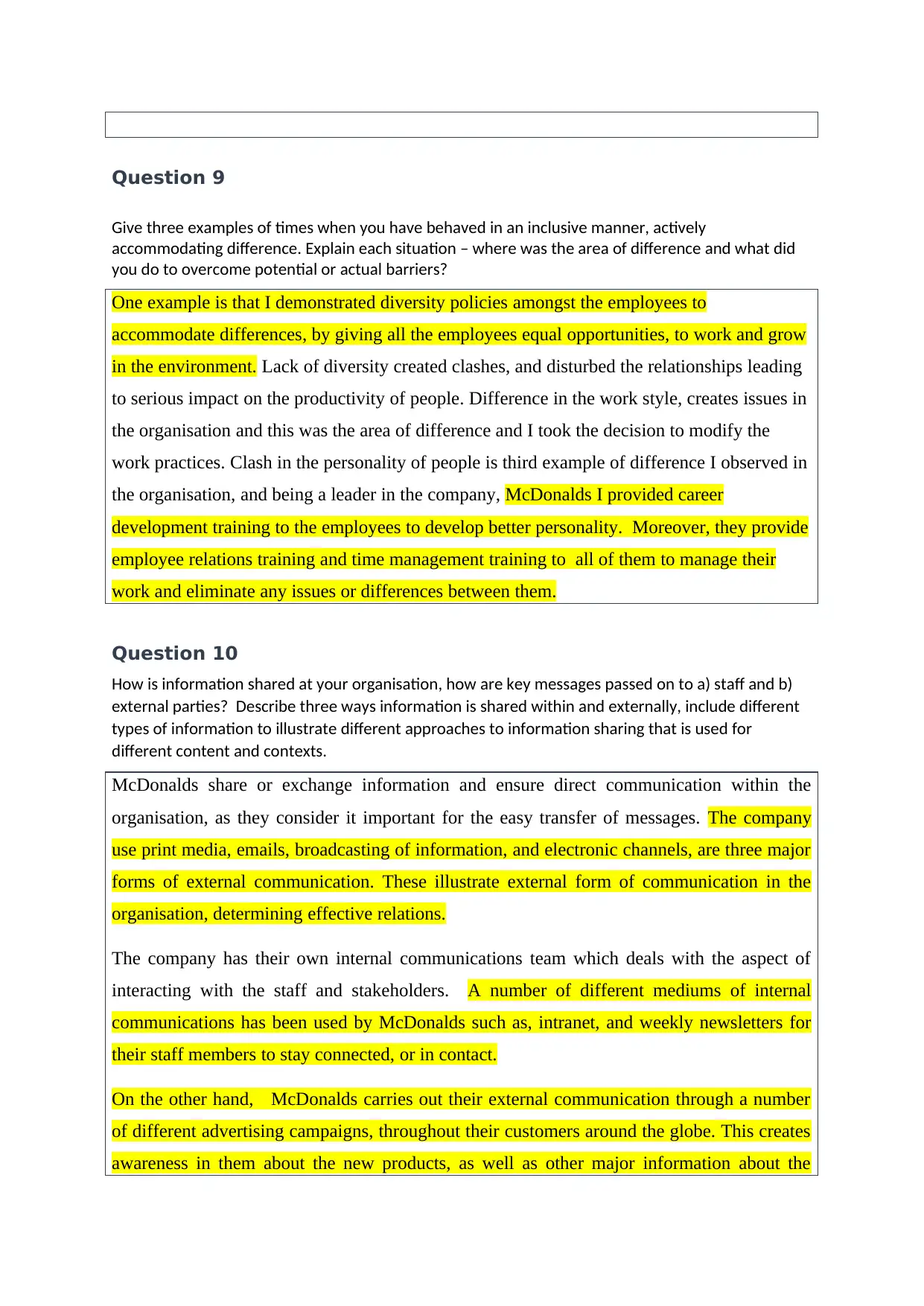
Question 9
Give three examples of times when you have behaved in an inclusive manner, actively
accommodating difference. Explain each situation – where was the area of difference and what did
you do to overcome potential or actual barriers?
One example is that I demonstrated diversity policies amongst the employees to
accommodate differences, by giving all the employees equal opportunities, to work and grow
in the environment. Lack of diversity created clashes, and disturbed the relationships leading
to serious impact on the productivity of people. Difference in the work style, creates issues in
the organisation and this was the area of difference and I took the decision to modify the
work practices. Clash in the personality of people is third example of difference I observed in
the organisation, and being a leader in the company, McDonalds I provided career
development training to the employees to develop better personality. Moreover, they provide
employee relations training and time management training to all of them to manage their
work and eliminate any issues or differences between them.
Question 10
How is information shared at your organisation, how are key messages passed on to a) staff and b)
external parties? Describe three ways information is shared within and externally, include different
types of information to illustrate different approaches to information sharing that is used for
different content and contexts.
McDonalds share or exchange information and ensure direct communication within the
organisation, as they consider it important for the easy transfer of messages. The company
use print media, emails, broadcasting of information, and electronic channels, are three major
forms of external communication. These illustrate external form of communication in the
organisation, determining effective relations.
The company has their own internal communications team which deals with the aspect of
interacting with the staff and stakeholders. A number of different mediums of internal
communications has been used by McDonalds such as, intranet, and weekly newsletters for
their staff members to stay connected, or in contact.
On the other hand, McDonalds carries out their external communication through a number
of different advertising campaigns, throughout their customers around the globe. This creates
awareness in them about the new products, as well as other major information about the
Give three examples of times when you have behaved in an inclusive manner, actively
accommodating difference. Explain each situation – where was the area of difference and what did
you do to overcome potential or actual barriers?
One example is that I demonstrated diversity policies amongst the employees to
accommodate differences, by giving all the employees equal opportunities, to work and grow
in the environment. Lack of diversity created clashes, and disturbed the relationships leading
to serious impact on the productivity of people. Difference in the work style, creates issues in
the organisation and this was the area of difference and I took the decision to modify the
work practices. Clash in the personality of people is third example of difference I observed in
the organisation, and being a leader in the company, McDonalds I provided career
development training to the employees to develop better personality. Moreover, they provide
employee relations training and time management training to all of them to manage their
work and eliminate any issues or differences between them.
Question 10
How is information shared at your organisation, how are key messages passed on to a) staff and b)
external parties? Describe three ways information is shared within and externally, include different
types of information to illustrate different approaches to information sharing that is used for
different content and contexts.
McDonalds share or exchange information and ensure direct communication within the
organisation, as they consider it important for the easy transfer of messages. The company
use print media, emails, broadcasting of information, and electronic channels, are three major
forms of external communication. These illustrate external form of communication in the
organisation, determining effective relations.
The company has their own internal communications team which deals with the aspect of
interacting with the staff and stakeholders. A number of different mediums of internal
communications has been used by McDonalds such as, intranet, and weekly newsletters for
their staff members to stay connected, or in contact.
On the other hand, McDonalds carries out their external communication through a number
of different advertising campaigns, throughout their customers around the globe. This creates
awareness in them about the new products, as well as other major information about the
Paraphrase This Document
Need a fresh take? Get an instant paraphrase of this document with our AI Paraphraser
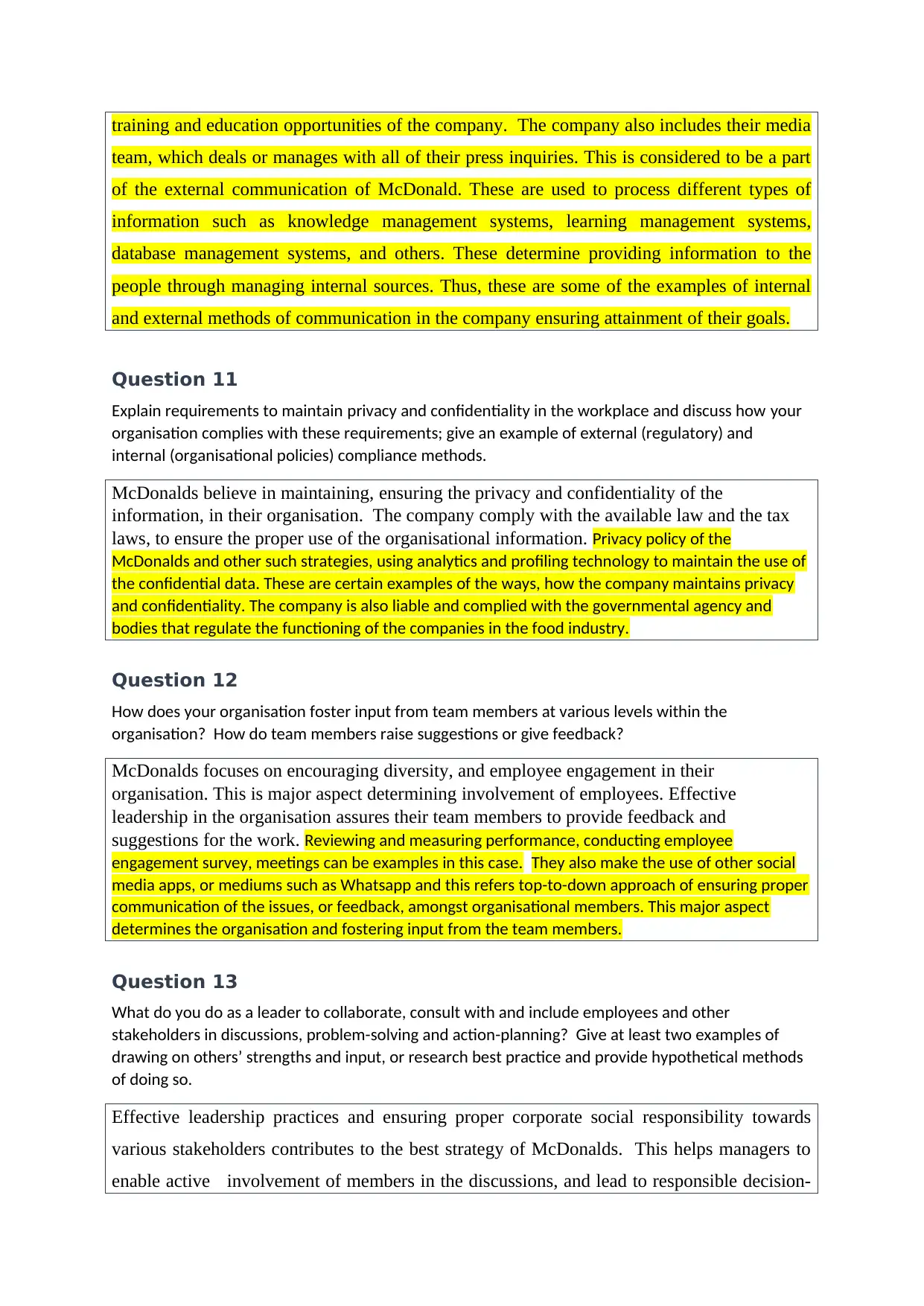
training and education opportunities of the company. The company also includes their media
team, which deals or manages with all of their press inquiries. This is considered to be a part
of the external communication of McDonald. These are used to process different types of
information such as knowledge management systems, learning management systems,
database management systems, and others. These determine providing information to the
people through managing internal sources. Thus, these are some of the examples of internal
and external methods of communication in the company ensuring attainment of their goals.
Question 11
Explain requirements to maintain privacy and confidentiality in the workplace and discuss how your
organisation complies with these requirements; give an example of external (regulatory) and
internal (organisational policies) compliance methods.
McDonalds believe in maintaining, ensuring the privacy and confidentiality of the
information, in their organisation. The company comply with the available law and the tax
laws, to ensure the proper use of the organisational information. Privacy policy of the
McDonalds and other such strategies, using analytics and profiling technology to maintain the use of
the confidential data. These are certain examples of the ways, how the company maintains privacy
and confidentiality. The company is also liable and complied with the governmental agency and
bodies that regulate the functioning of the companies in the food industry.
Question 12
How does your organisation foster input from team members at various levels within the
organisation? How do team members raise suggestions or give feedback?
McDonalds focuses on encouraging diversity, and employee engagement in their
organisation. This is major aspect determining involvement of employees. Effective
leadership in the organisation assures their team members to provide feedback and
suggestions for the work. Reviewing and measuring performance, conducting employee
engagement survey, meetings can be examples in this case. They also make the use of other social
media apps, or mediums such as Whatsapp and this refers top-to-down approach of ensuring proper
communication of the issues, or feedback, amongst organisational members. This major aspect
determines the organisation and fostering input from the team members.
Question 13
What do you do as a leader to collaborate, consult with and include employees and other
stakeholders in discussions, problem-solving and action-planning? Give at least two examples of
drawing on others’ strengths and input, or research best practice and provide hypothetical methods
of doing so.
Effective leadership practices and ensuring proper corporate social responsibility towards
various stakeholders contributes to the best strategy of McDonalds. This helps managers to
enable active involvement of members in the discussions, and lead to responsible decision-
team, which deals or manages with all of their press inquiries. This is considered to be a part
of the external communication of McDonald. These are used to process different types of
information such as knowledge management systems, learning management systems,
database management systems, and others. These determine providing information to the
people through managing internal sources. Thus, these are some of the examples of internal
and external methods of communication in the company ensuring attainment of their goals.
Question 11
Explain requirements to maintain privacy and confidentiality in the workplace and discuss how your
organisation complies with these requirements; give an example of external (regulatory) and
internal (organisational policies) compliance methods.
McDonalds believe in maintaining, ensuring the privacy and confidentiality of the
information, in their organisation. The company comply with the available law and the tax
laws, to ensure the proper use of the organisational information. Privacy policy of the
McDonalds and other such strategies, using analytics and profiling technology to maintain the use of
the confidential data. These are certain examples of the ways, how the company maintains privacy
and confidentiality. The company is also liable and complied with the governmental agency and
bodies that regulate the functioning of the companies in the food industry.
Question 12
How does your organisation foster input from team members at various levels within the
organisation? How do team members raise suggestions or give feedback?
McDonalds focuses on encouraging diversity, and employee engagement in their
organisation. This is major aspect determining involvement of employees. Effective
leadership in the organisation assures their team members to provide feedback and
suggestions for the work. Reviewing and measuring performance, conducting employee
engagement survey, meetings can be examples in this case. They also make the use of other social
media apps, or mediums such as Whatsapp and this refers top-to-down approach of ensuring proper
communication of the issues, or feedback, amongst organisational members. This major aspect
determines the organisation and fostering input from the team members.
Question 13
What do you do as a leader to collaborate, consult with and include employees and other
stakeholders in discussions, problem-solving and action-planning? Give at least two examples of
drawing on others’ strengths and input, or research best practice and provide hypothetical methods
of doing so.
Effective leadership practices and ensuring proper corporate social responsibility towards
various stakeholders contributes to the best strategy of McDonalds. This helps managers to
enable active involvement of members in the discussions, and lead to responsible decision-
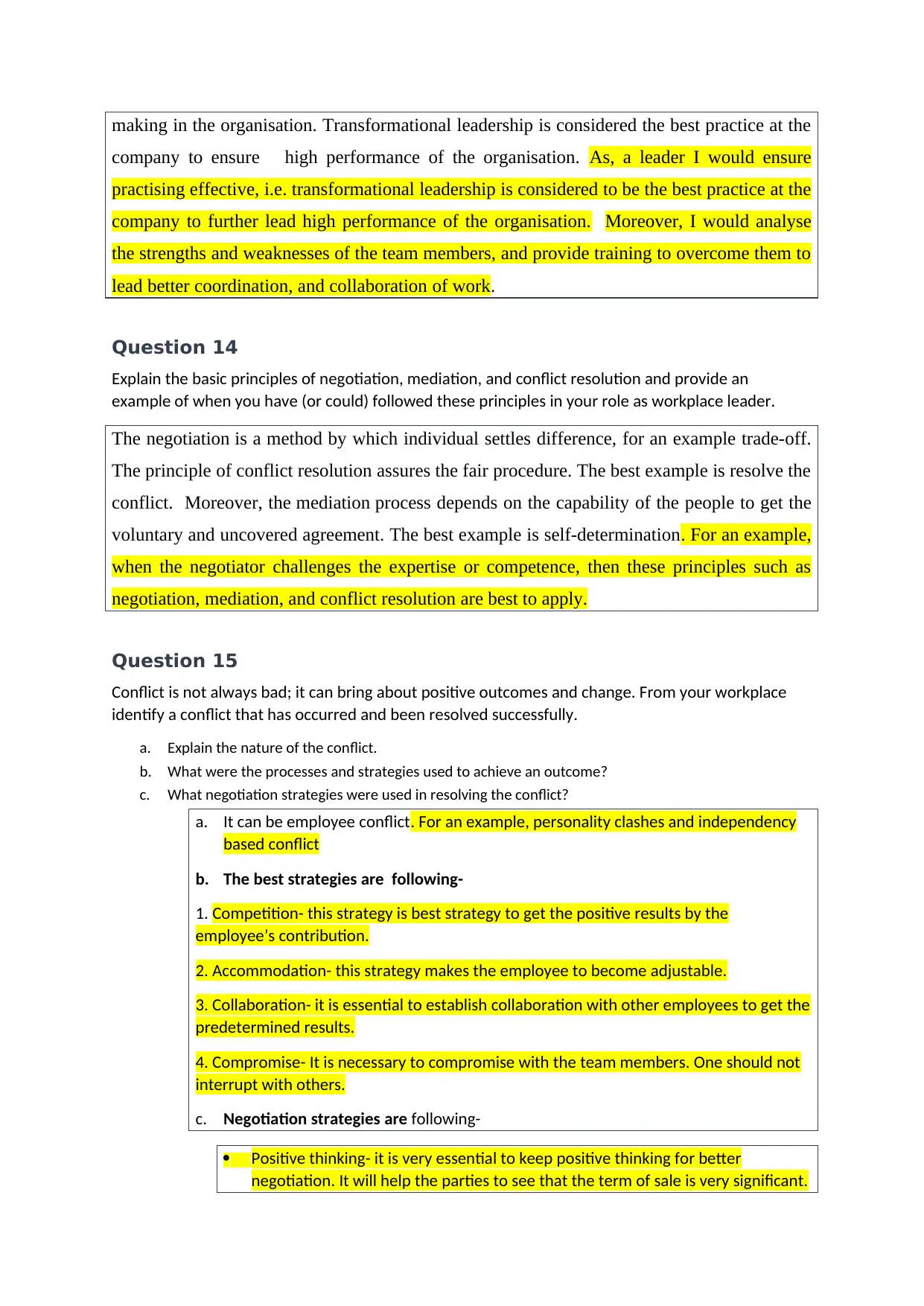
making in the organisation. Transformational leadership is considered the best practice at the
company to ensure high performance of the organisation. As, a leader I would ensure
practising effective, i.e. transformational leadership is considered to be the best practice at the
company to further lead high performance of the organisation. Moreover, I would analyse
the strengths and weaknesses of the team members, and provide training to overcome them to
lead better coordination, and collaboration of work.
Question 14
Explain the basic principles of negotiation, mediation, and conflict resolution and provide an
example of when you have (or could) followed these principles in your role as workplace leader.
The negotiation is a method by which individual settles difference, for an example trade-off.
The principle of conflict resolution assures the fair procedure. The best example is resolve the
conflict. Moreover, the mediation process depends on the capability of the people to get the
voluntary and uncovered agreement. The best example is self-determination. For an example,
when the negotiator challenges the expertise or competence, then these principles such as
negotiation, mediation, and conflict resolution are best to apply.
Question 15
Conflict is not always bad; it can bring about positive outcomes and change. From your workplace
identify a conflict that has occurred and been resolved successfully.
a. Explain the nature of the conflict.
b. What were the processes and strategies used to achieve an outcome?
c. What negotiation strategies were used in resolving the conflict?
a. It can be employee conflict. For an example, personality clashes and independency
based conflict
b. The best strategies are following-
1. Competition- this strategy is best strategy to get the positive results by the
employee’s contribution.
2. Accommodation- this strategy makes the employee to become adjustable.
3. Collaboration- it is essential to establish collaboration with other employees to get the
predetermined results.
4. Compromise- It is necessary to compromise with the team members. One should not
interrupt with others.
c. Negotiation strategies are following-
Positive thinking- it is very essential to keep positive thinking for better
negotiation. It will help the parties to see that the term of sale is very significant.
company to ensure high performance of the organisation. As, a leader I would ensure
practising effective, i.e. transformational leadership is considered to be the best practice at the
company to further lead high performance of the organisation. Moreover, I would analyse
the strengths and weaknesses of the team members, and provide training to overcome them to
lead better coordination, and collaboration of work.
Question 14
Explain the basic principles of negotiation, mediation, and conflict resolution and provide an
example of when you have (or could) followed these principles in your role as workplace leader.
The negotiation is a method by which individual settles difference, for an example trade-off.
The principle of conflict resolution assures the fair procedure. The best example is resolve the
conflict. Moreover, the mediation process depends on the capability of the people to get the
voluntary and uncovered agreement. The best example is self-determination. For an example,
when the negotiator challenges the expertise or competence, then these principles such as
negotiation, mediation, and conflict resolution are best to apply.
Question 15
Conflict is not always bad; it can bring about positive outcomes and change. From your workplace
identify a conflict that has occurred and been resolved successfully.
a. Explain the nature of the conflict.
b. What were the processes and strategies used to achieve an outcome?
c. What negotiation strategies were used in resolving the conflict?
a. It can be employee conflict. For an example, personality clashes and independency
based conflict
b. The best strategies are following-
1. Competition- this strategy is best strategy to get the positive results by the
employee’s contribution.
2. Accommodation- this strategy makes the employee to become adjustable.
3. Collaboration- it is essential to establish collaboration with other employees to get the
predetermined results.
4. Compromise- It is necessary to compromise with the team members. One should not
interrupt with others.
c. Negotiation strategies are following-
Positive thinking- it is very essential to keep positive thinking for better
negotiation. It will help the parties to see that the term of sale is very significant.
⊘ This is a preview!⊘
Do you want full access?
Subscribe today to unlock all pages.

Trusted by 1+ million students worldwide
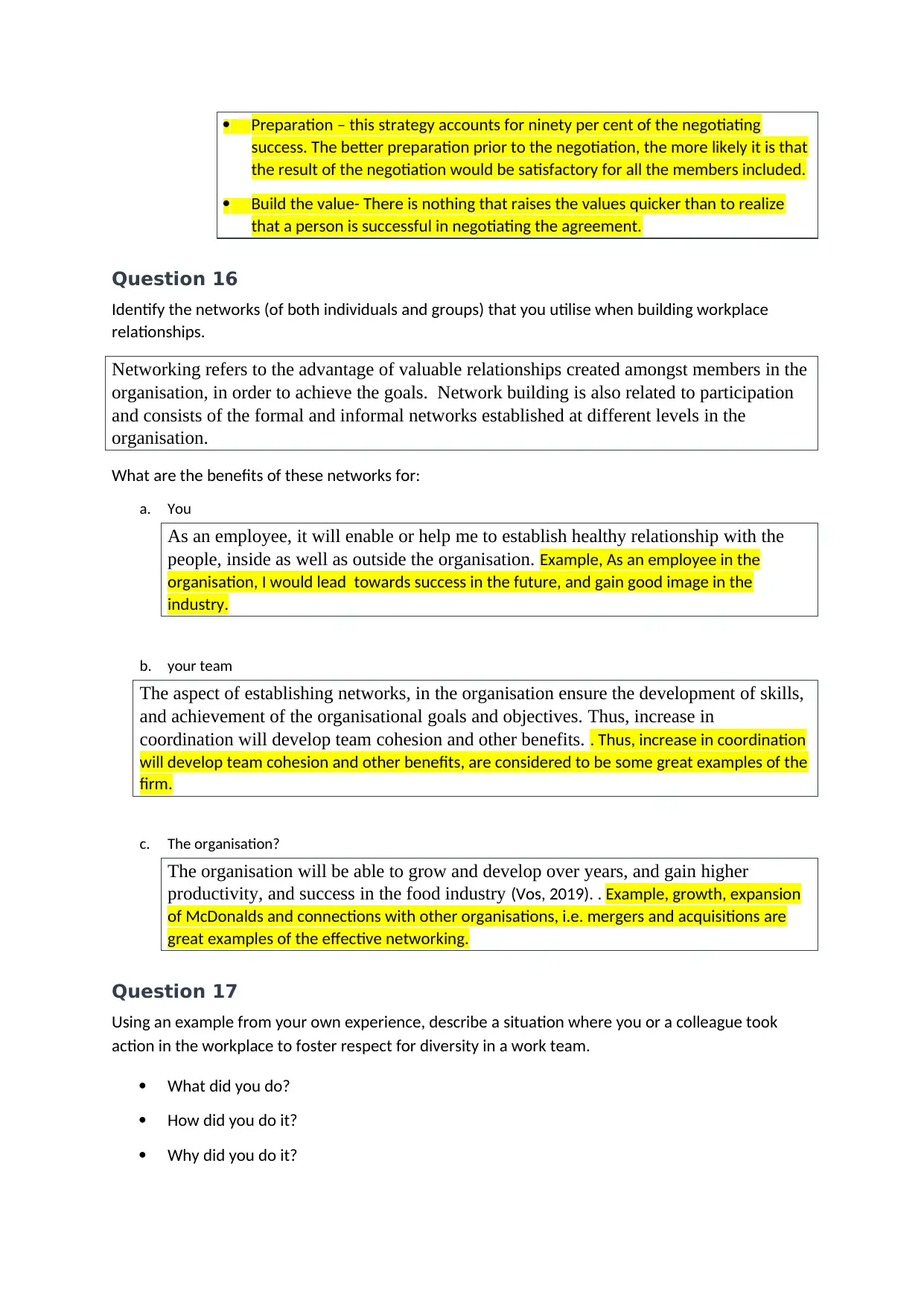
Preparation – this strategy accounts for ninety per cent of the negotiating
success. The better preparation prior to the negotiation, the more likely it is that
the result of the negotiation would be satisfactory for all the members included.
Build the value- There is nothing that raises the values quicker than to realize
that a person is successful in negotiating the agreement.
Question 16
Identify the networks (of both individuals and groups) that you utilise when building workplace
relationships.
Networking refers to the advantage of valuable relationships created amongst members in the
organisation, in order to achieve the goals. Network building is also related to participation
and consists of the formal and informal networks established at different levels in the
organisation.
What are the benefits of these networks for:
a. You
As an employee, it will enable or help me to establish healthy relationship with the
people, inside as well as outside the organisation. Example, As an employee in the
organisation, I would lead towards success in the future, and gain good image in the
industry.
b. your team
The aspect of establishing networks, in the organisation ensure the development of skills,
and achievement of the organisational goals and objectives. Thus, increase in
coordination will develop team cohesion and other benefits. . Thus, increase in coordination
will develop team cohesion and other benefits, are considered to be some great examples of the
firm.
c. The organisation?
The organisation will be able to grow and develop over years, and gain higher
productivity, and success in the food industry (Vos, 2019). . Example, growth, expansion
of McDonalds and connections with other organisations, i.e. mergers and acquisitions are
great examples of the effective networking.
Question 17
Using an example from your own experience, describe a situation where you or a colleague took
action in the workplace to foster respect for diversity in a work team.
What did you do?
How did you do it?
Why did you do it?
success. The better preparation prior to the negotiation, the more likely it is that
the result of the negotiation would be satisfactory for all the members included.
Build the value- There is nothing that raises the values quicker than to realize
that a person is successful in negotiating the agreement.
Question 16
Identify the networks (of both individuals and groups) that you utilise when building workplace
relationships.
Networking refers to the advantage of valuable relationships created amongst members in the
organisation, in order to achieve the goals. Network building is also related to participation
and consists of the formal and informal networks established at different levels in the
organisation.
What are the benefits of these networks for:
a. You
As an employee, it will enable or help me to establish healthy relationship with the
people, inside as well as outside the organisation. Example, As an employee in the
organisation, I would lead towards success in the future, and gain good image in the
industry.
b. your team
The aspect of establishing networks, in the organisation ensure the development of skills,
and achievement of the organisational goals and objectives. Thus, increase in
coordination will develop team cohesion and other benefits. . Thus, increase in coordination
will develop team cohesion and other benefits, are considered to be some great examples of the
firm.
c. The organisation?
The organisation will be able to grow and develop over years, and gain higher
productivity, and success in the food industry (Vos, 2019). . Example, growth, expansion
of McDonalds and connections with other organisations, i.e. mergers and acquisitions are
great examples of the effective networking.
Question 17
Using an example from your own experience, describe a situation where you or a colleague took
action in the workplace to foster respect for diversity in a work team.
What did you do?
How did you do it?
Why did you do it?
Paraphrase This Document
Need a fresh take? Get an instant paraphrase of this document with our AI Paraphraser
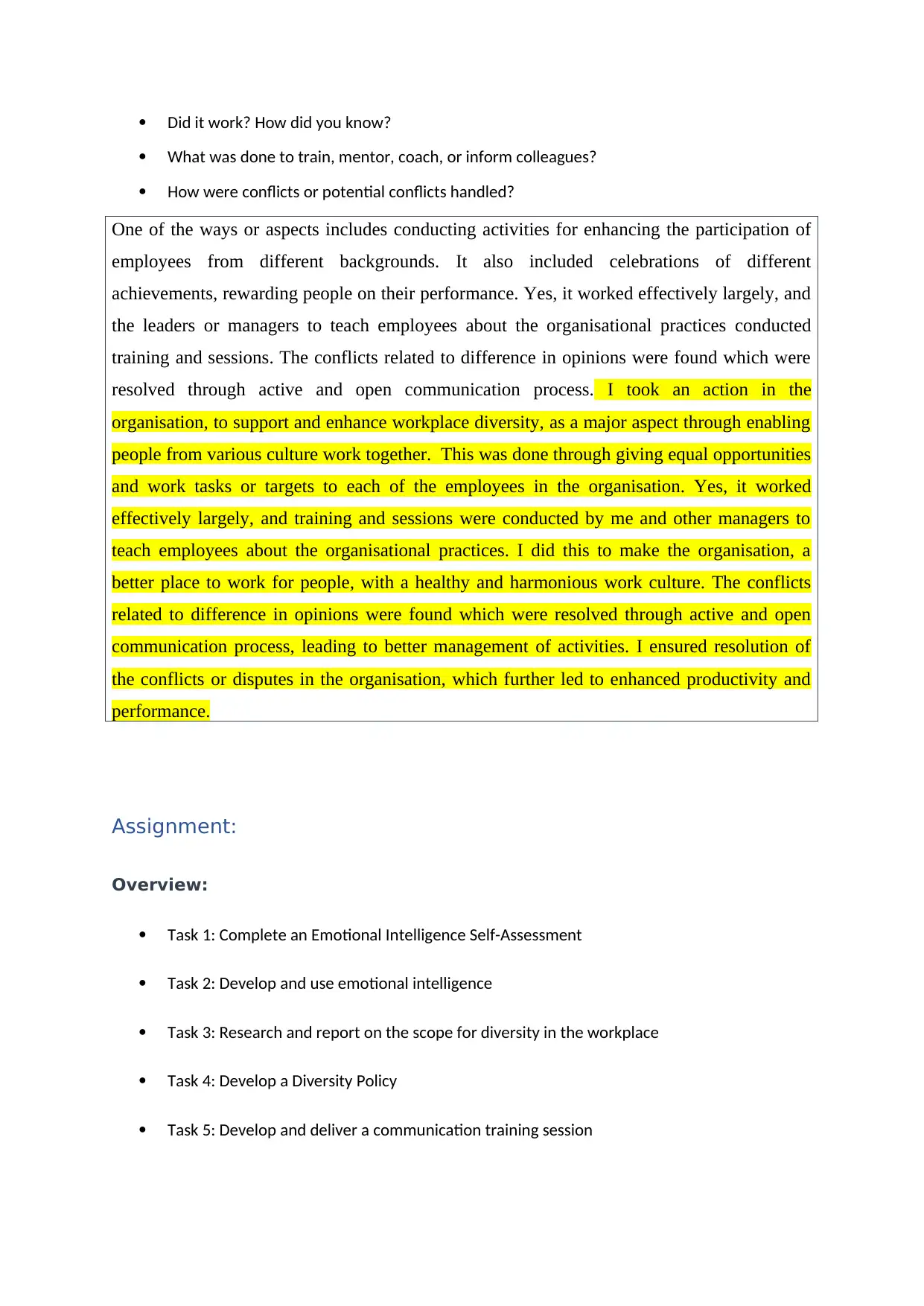
Did it work? How did you know?
What was done to train, mentor, coach, or inform colleagues?
How were conflicts or potential conflicts handled?
One of the ways or aspects includes conducting activities for enhancing the participation of
employees from different backgrounds. It also included celebrations of different
achievements, rewarding people on their performance. Yes, it worked effectively largely, and
the leaders or managers to teach employees about the organisational practices conducted
training and sessions. The conflicts related to difference in opinions were found which were
resolved through active and open communication process. I took an action in the
organisation, to support and enhance workplace diversity, as a major aspect through enabling
people from various culture work together. This was done through giving equal opportunities
and work tasks or targets to each of the employees in the organisation. Yes, it worked
effectively largely, and training and sessions were conducted by me and other managers to
teach employees about the organisational practices. I did this to make the organisation, a
better place to work for people, with a healthy and harmonious work culture. The conflicts
related to difference in opinions were found which were resolved through active and open
communication process, leading to better management of activities. I ensured resolution of
the conflicts or disputes in the organisation, which further led to enhanced productivity and
performance.
Assignment:
Overview:
Task 1: Complete an Emotional Intelligence Self-Assessment
Task 2: Develop and use emotional intelligence
Task 3: Research and report on the scope for diversity in the workplace
Task 4: Develop a Diversity Policy
Task 5: Develop and deliver a communication training session
What was done to train, mentor, coach, or inform colleagues?
How were conflicts or potential conflicts handled?
One of the ways or aspects includes conducting activities for enhancing the participation of
employees from different backgrounds. It also included celebrations of different
achievements, rewarding people on their performance. Yes, it worked effectively largely, and
the leaders or managers to teach employees about the organisational practices conducted
training and sessions. The conflicts related to difference in opinions were found which were
resolved through active and open communication process. I took an action in the
organisation, to support and enhance workplace diversity, as a major aspect through enabling
people from various culture work together. This was done through giving equal opportunities
and work tasks or targets to each of the employees in the organisation. Yes, it worked
effectively largely, and training and sessions were conducted by me and other managers to
teach employees about the organisational practices. I did this to make the organisation, a
better place to work for people, with a healthy and harmonious work culture. The conflicts
related to difference in opinions were found which were resolved through active and open
communication process, leading to better management of activities. I ensured resolution of
the conflicts or disputes in the organisation, which further led to enhanced productivity and
performance.
Assignment:
Overview:
Task 1: Complete an Emotional Intelligence Self-Assessment
Task 2: Develop and use emotional intelligence
Task 3: Research and report on the scope for diversity in the workplace
Task 4: Develop a Diversity Policy
Task 5: Develop and deliver a communication training session
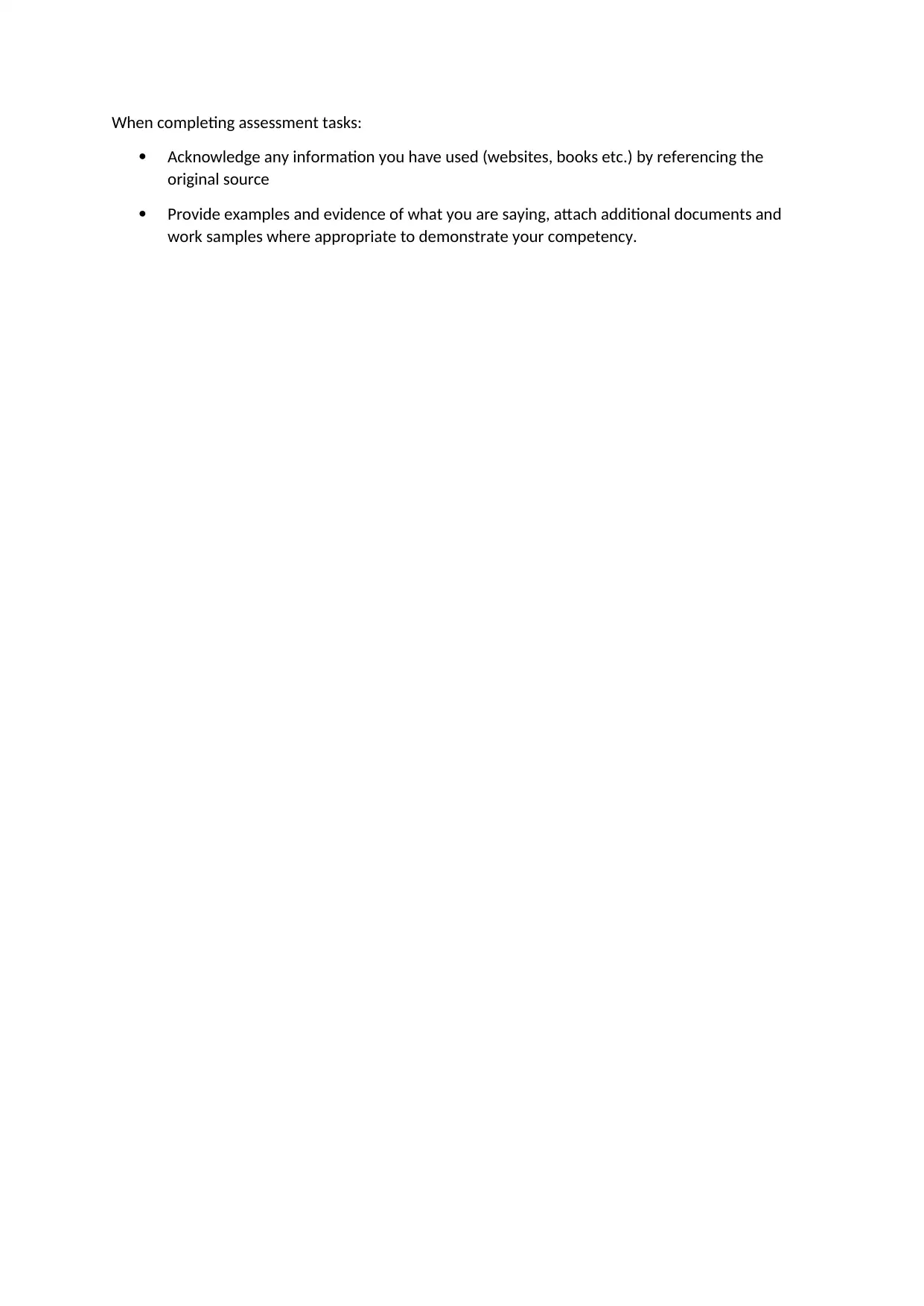
When completing assessment tasks:
Acknowledge any information you have used (websites, books etc.) by referencing the
original source
Provide examples and evidence of what you are saying, attach additional documents and
work samples where appropriate to demonstrate your competency.
Acknowledge any information you have used (websites, books etc.) by referencing the
original source
Provide examples and evidence of what you are saying, attach additional documents and
work samples where appropriate to demonstrate your competency.
⊘ This is a preview!⊘
Do you want full access?
Subscribe today to unlock all pages.

Trusted by 1+ million students worldwide
1 out of 36
Related Documents
Your All-in-One AI-Powered Toolkit for Academic Success.
+13062052269
info@desklib.com
Available 24*7 on WhatsApp / Email
![[object Object]](/_next/static/media/star-bottom.7253800d.svg)
Unlock your academic potential
Copyright © 2020–2025 A2Z Services. All Rights Reserved. Developed and managed by ZUCOL.




